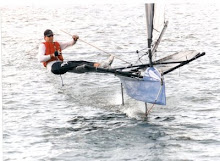
One of the challenges in building your own boat is to create systems that work (usually copying those on production boats) using materials at hand. The picture above shows my inner tiller mechanism I have to control the AoA of the rudder foil. The piece on the left shows the forward end of the inner tiller; the entire piece is about 28 inches long. On the aft end (out of the photo) is a slot for the rudder pin, a slot that also extends through the outer tiller. The pin attaches top and bottom to the fixed gantry. As the inner tiller moves fore and aft, the rudder cassette moves and alters the AoA of the foil. To force the inner tiller fore and aft is the worm gear show in the photo. It consists of a captive nut, a 1/4"-20 ss machine screw which is fixed in a "spool", that in turn is turned by twisting the hiking stick. The spool is held captive in the tiller by two sleeves, fixed by set screws through the outer tiller. Since the spool can't move fore and aft, any rotation of the machine screw will pull or push the inner tiller. And everything was working for a while....

Sometime either Thursday or Friday at Weymouth, the "captive" nut broke loose from the inner tiller, resulting in no fore and aft control of the rudder foil. Needless to say, the boat was unmanagable in the 20+ knots of breeze we had. I went out Friday for the last day of racing, but couldn't get the boat downwind -- it kept jumping out with violent stacks. My guess is that the water pressure was pushing the rudder aft and hence generating a negative angle of attack on the rudder foil which pulled the stern down and created a positive AoA on the main foil that the flap could not counter. At any rate, I had to come back in and counted four DNC's for Friday's races.
So the first order of business is to reset the nut so that it can't come loose. I've notched the points of the hex nut with a hacksaw to allow the thickened epoxy to key onto the nut. I've also put a flat piece of carbon (with a hole for the bolt) over the nut. Hopefully, these will keep the nut where it belongs. Of course I've learned that it's always the weak link that breaks, so if this problem is fixed, then there maybe a failure somewhere else....such is the life of the home builder: learn to sail the beast and also how to keep it together. I guess the bright side is that I don't have to rely on the factory repair team to fix every little glitch.



No comments:
Post a Comment